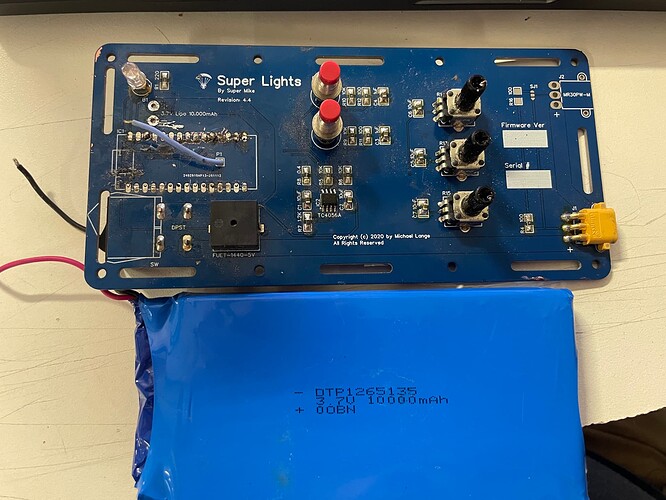I’m considering making a product with the pixelblaze. Is it possible to charge the connected battery through the USB interface of the pixelblaze?
Hey! Did you finish your powered paraglider LED project? Got any pics?
You likely need a charging circuit between the battery, charging port, and the load (the Pixelblaze + LEDs). Here’s a bunch:
https://www.sparkfun.com/categories/421
These small circuits can play a lot of useful roles: control the charging current curve, prevent over-discharge, or even provide a steady voltage / current over the discharge cycle.
Since you’re making a product, you should reach out to @wizard over DM to see if he could make a version that includes this. Since Pixelblaze is already the best solution in the world for portable stuff like props, wearables, totems, etc - I could see being a useful add to the product lineup.
That’s what I was planning to work on now. I bought a used set of PPG lights from a friend, and the NANO just went up in smoke when I plugged it in.
The battery is 10000mAh 3.7v Lipo. When all 100 LEDs were lit, they would dim quite a bit, especially when white.
I checked the board and it used a TC4056A circuit to charge the battery and distribute to the battery and board. Power was plugged directly into the arduino. https://www.addicore.com/TP4056-Charger-and-Protection-Module-p/ad310.htm
Here is the battery: https://m.made-in-china.com/product/Rechargeable-Li-ion-Cell-3-7V-10000mAh-Dtp1265135-Lithium-Polymer-Battery-888131985.html
I can’t commit a ton of time to this because us PPG pilots are super niche. It wouldn’t be a huge income for me. But if I can get some PCB’s made overseas to avoid soldering work, it could be worth it and fun.
I essentially need to step up the voltage to 5V to supply the LED’s and board. I suppose I can use 5V leds instead of 12V. I’m thinking maybe something like this instead of the TC4056a: https://www.adafruit.com/product/259. I believe this has a max output current that may not be sufficient. Can’t be sure though.
The biggest problem is I don’t have extensive knowledge in circuitry. If I have the right parts, I can solder and set it up no problem, but actually finding the parts I need is difficult for me, and I’d probably end up spending more than I need to achieve the same purpose.
Ultimately, I suppose I can just simplify this all by requiring the user to unplug the battery and charge it manually through a battery charger, but then I’d have to include a charger and it’s more work for the user.
Best example I have of the lights, but definitely not the best example of my launch: https://photos.app.goo.gl/tHKswTiarCgnUhg59
Any tips or help with circuitry or boards would be greatly appreciated!
Sorry for all the posts. It won’t let me post more than 1 link
I hear you with the desire to make charging as simple as plugging-in. The e-Bike industry almost certainly has stuff for this - though it’s a 36V pack, I just plug in a barrel connector to charge my bike, and it’s LiPos.
I would suggest looking into stepping down 2S (7.4V) hardshell packs (example) to 5V instead of boosting 3.7V to 5V.
I want to raise my hand here and indicate some interest. I’ve built a number of personal LED devices that are powered off typical RC or drone 3S or 4S batteries. I’m starting to develop a wish list of sorts for a small compact PCB that would have the following
- low voltage trigger
- recharging circuit
- master on/off switch
- fuse
i actually want this to be separate from the PB since I usually locate this closer to the battery source which is not always adjacent to where the LEDs are.
if theres anything out there that checks those boxes, i’d love to know about it! or should we even design our own… my PCB-fu isn’t very good.
https://photos.app.goo.gl/Ae7wCwRRhkWbTfCd6
This is a clip I sent to a friend ^
I think your advice is sound. Probably easier to step down voltage. I just need to find a decent lipo charge board.
